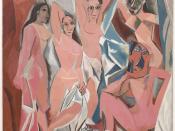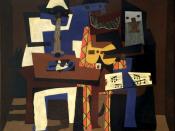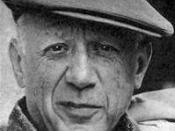Cubism
The appearance of Fauve art had surprised and shocked the Paris art world in 1905. Two years later even the Fauve artists themselves were startled by the experiments begun by Pablo Picasso. Picasso, a Spaniard, had come to Paris to practice his art. He had won initial success with bluish, melancholy paintings. Then in 1907 he tried something completely different. Influenced by the art of African sculpture, he began to look at the human figure as sculpture. He painted faces and bodies as if he were cutting them into solid shapes with a knife rather than a paint brush. In so doing, he depicted shapes in simple, geometric forms, discovering the cubes, triangles, and spheres that are the basic shapes of the human head and figure. For this reason, Picasso's new painting approach was called Cubism.
Picasso attracted a few artists to his ideas, especially Georges Braque. The two worked so closely that it's often difficult to tell which painting belongs to whom, at least in the early years of Cubism.
They didn't stop with their early experiments, but pushed their ideas further. In each of their experiments, they analyzed the forms of their subjects. Soon they began painting not just portraits and figures but other objects, like musical instruments, bottles, and fruit.
At first Picasso and Braque interested themselves only with the forms of their subjects and tended to disregard color. Gradually they introduced more color into their Cubist paintings. With that, more painters began working in the Cubist manner. Among the better known were Juan Girls, Fernand Leger, and Jacques Villon. All these artists simplified the forms of their subjects to more or less geometric shapes. The geometrical view of the Cubists soon influenced other artists and movements in other countries. In our country, Stuart...



Good but not well research
Good work but Picasso is not the first to paint in a cubist manner. Since you had titled your essay as "Cubism", I think you should cover every scope of it. You have left out a important person, Paul Cezanne. Cezanne was the person who inspired and influenced Picasso to start painting in a cubist manner. Anyway, overall this is a piece of good essay.
1 out of 1 people found this comment useful.